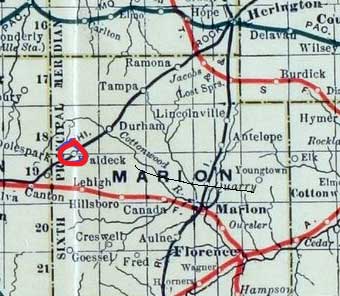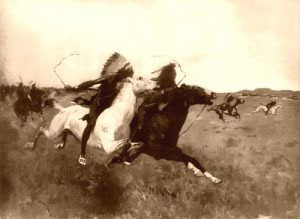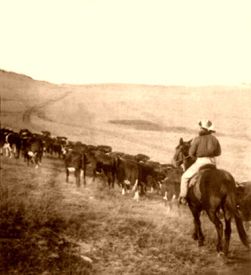
Waldeck, Kansas General Area today, courtesy Google Maps.
Waldeck, Kansas, in Marion County, was first situated along the Santa Fe Trail.
In 1861, French emigrants Claude Frances Laloge, known as “French Frank,” and Peter Martin established a road ranch at what was known as Cottonwood Holes. They were the first Homesteaders in the area. Cottonwood Holes got its name because it was the first water that could be found west of the Cottonwood Crossing, and the water was found in small depressions along the creek. The two men likely chose the location because of its proximity to other French-speaking settlers. French Frank’s Ranch offered meals and small provisions to trail travelers as well as provisions that could be purchased.
On June 20, 1864, Ed Miller stopped for breakfast at French Frank’s Road Ranch, left by himself at about 8:00 a.m., and headed west. Unfortunately, he soon ran into a group of Indians, who chased him down and killed him about four miles west of the ranch. The search party found his body on June 23, 1864, and buried him beside the trail near where they found him. His grave is marked and can be seen today.
The ranch likely ceased operation in 1866 when trail traffic shifted away from this area of Marion County. The creek in the area is named French Creek in honor of Mr. Laloge because his road ranch was near the head of the creek.
Today, there are at least six visible swales that follow a northeast-southwest route that connected the Cottonwood Creek Crossing and the Little Arkansas River crossings along the main route of the Santa Fe Trail. The area also displays the “Cottonwood Holes,” referred to in trail-era accounts, the site of a former trail-period ranch, and a 1907 commemorative marker erected by the Daughters of the American Revolution. The site is on the National Register of Historic Places in 2013 for its significance in the areas of transportation, commerce, and social history.
French Frank’s Trail Segment is four miles north of Lehigh, on the west side of Chisholm Trail Road, just south of Union Pacific Railroad tracks. On 245th Road, about ¼ mile west of Chisholm Trail Road, is a D.A.R marker and Santa Fe Trail crossing sign. The swales are clearly visible, running to the southwest from the marker. Running across the land to the southwest are four sets of two parallel swales, apparently created as travelers chose different routes over the years to cross the creek south of the marker.
The site of Waldeck was also on the Chisholm Trail when it crossed Marion County from 1867 to 1871.
In 1887, the Chicago, Kansas, and Nebraska Railway built a main line from Herington through Waldeck to Pratt. It became a coal and water stop for the railroad during the steam era. A siding was also built about a mile away. Swiss immigrants most likely named the town after the former Waldeck sovereign principality in the German Empire. The construction of this line meant that the Chisholm Trail no longer needed to go the additional 40 miles to Abilene, Kansas.
The Golden Belt Town Company purchased land and formed a town site in October 1887. A post office was established on August 10, 1889. However, the town didn’t flourish as its investors had hoped, and the townsite was sold at a loss to the Kansas Town and Loan Company in the 1890s. A two-block town was platted on December 7, 1899, and soon, a small general store and a school were built.
Still, the town didn’t thrive, and its post office closed on February 14, 1903. Among the last usable structures of Waldeck — the cattle corrals were operational until the early 1950s when diesel locomotives became dominant.
Today, no buildings remain of this former community. It was located approximately 3.5 miles north of Lehigh, next to the railroad.

1915 Railroad Map with the extinct town of Waldeck circled.
©Kathy Alexander/Legends of Kansas, updated November 2023.
Also See:
Extinct Towns of Marion County
Santa Fe Trail in Marion County
Santa Fe Trail – Highway to the Southwest
Sources:
Kansas Historical Society
Cottonwood Crossing Auto Tour
Santa Fe Trail Research
Wikipedia


